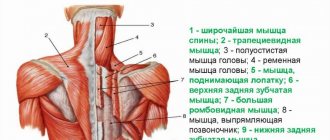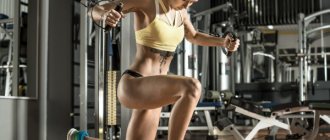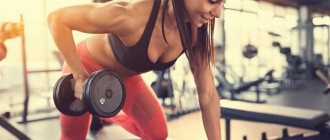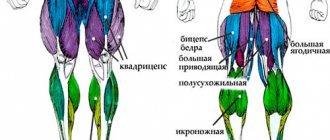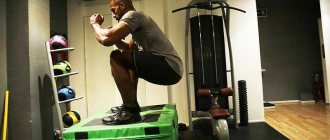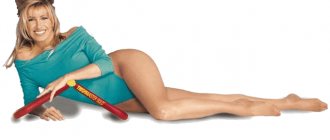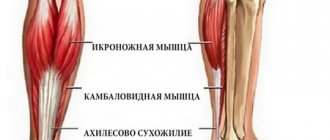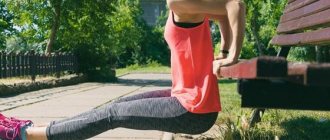Legs are the largest muscle group in the human body and it is not surprising that working them out requires a serious approach! Find out how to pump up your leg muscles! The best exercises, workouts and recommendations!
If you have never asked the question “how to pump up your legs,” then you are the wrong bodybuilder. And that's why:
- Firstly, during training in the gym you cannot constantly pump up only your biceps and abs; the upper part of the body becomes pumped, while the lower part lacks strength and muscle mass. An imbalance occurs in the figure, which is fundamentally wrong for bodybuilding.
- Secondly, even if you have been training for a long time, from time to time it is worth stopping yourself and clarifying the technique of pumping up your legs, looking for new exercises, building new workouts to prevent muscle adaptation.
Even girls should think about this issue, because leg training is the most exhausting and energy-consuming, which means it is perfect as a training for weight loss.
In addition, the fair sex should strive to pump up beautiful legs, because a pair of slender, graceful legs is the dream of every girl and the delight of every man! Therefore, if you are the right bodybuilder or fitness girl, if you want to lose weight, gain definition or build muscle mass, there is only one answer - pump up your legs!
As a result, we will come to similar variations of leg pumping in the gym. If you are already rushing into battle, wait and watch the material to the end.
Training for experienced athletes
Treadmill workout
- 5 minutes at an easy pace and 10 accelerations of 200 meters
- Body part: Quadriceps Equipment: Exercise
Squats without weights
- 2 sets of 30 reps
- Body part: Quadriceps Equipment: Body weight
Quick squats with a barbell
- 3 sets of 10 reps
- Body part: Quadriceps Equipment: Barbell
Hack squats with narrow feet
- 3 sets of 10 reps
- Body part: Quadriceps Equipment: Exercise
Bulgarian split squat with rear leg hanging
- 3 sets of 10 reps
- Body Part: Quadriceps Equipment: Other
Attention: on each leg, to failure
Lunges with dumbbells
- 3 sets of 15 reps
- Body part: Quadriceps Equipment: Dumbbells
Attention: on each leg, to failure
Add to Calendar * Add to My Workouts * Print Workout
* — The service is in beta testing
All you can think about is how to get beautiful legs with impressive muscles? We agree, skinny legs don’t impress anyone! Powerful leg muscles are at your fingertips with these intermediate and advanced workouts. Further in the article you will find other options for beginners.
Number of workouts per week to achieve maximum effect
To pump up beautiful lower limbs, it is recommended to train 3 times a week. The duration of the lesson is 20-35 minutes.
What fitness approaches can be combined with in one day and why to do it:
- running at a moderate pace;
- jumping rope;
- stretching exercises.
These loads accelerate metabolism well and speed up metabolism.
If training is properly organized, a tolerable tension and tingling sensation is felt in the calf muscles.
Important: acute pain in the joints when performing exercises to pump up muscles requires immediate cessation of sports activities! If the area around the joint is swollen and red, then the person needs to see a doctor.
Why pump up your leg muscles?
The general plan of any gym goer should be to develop a program that will develop all muscle mass in a balanced manner. This means that each muscle group requires regular and alternating training.
For optimal results, each muscle group must work in conjunction with each other.
Whether you're working on bulking up or looking to gain strength and boost your metabolism, you should definitely do exercises that will help you tone your legs.
The legs, particularly the muscles of the upper thighs, are the largest muscle groups in the entire body. Regardless of your goals, they are the source of strength. That is why exercises to pump up leg muscles should be included in any workout.
In many strength exercises you work the muscles of the shoulders, chest and arms, but keep in mind that the legs are the source of strength and energy in any load. Strong legs will allow you to:
- Lift heavier weights
- Create a foundation for the growth of other muscle groups
- form a powerful source of lean muscle mass, which will speed up metabolism
What do we need for proper leg training?
- Correctly selected exercises . We have already decided that the priority will be basic exercises. They will help build muscle mass.
- Progression of loads. In order to avoid stagnation in muscle growth, we will need to constantly add working weight. Let it be little by little, 1 kg at a time, but the progression should be constant. Of course, under no circumstances approach this point with great fanaticism. We add weight gradually as you become more trained.
- Warm up at the beginning of the workout. This is a very important component in the training process. Warm-up will help warm up your muscles for hard work. The same applies to warm-up approaches.
- Stretching at the end of your workout. Remember once and for all - stretching is done only at the end of the workout! But why? Because during stretching, the muscle relaxes, which promotes its speedy recovery and minimizes muscle pain the next day after training. And also, it stretches the muscle fibers that remain in a bound state after hard work on the legs in the gym. If we stretch at the beginning, we will relax the muscles and they are unlikely to be able to work to their maximum.
- Periodization of loads. That is, alternating training on fast (BMW) and slow muscle fibers (MMF). What is the difference between them? BMWs are white and designed for hard work, but get tired quickly. Therefore, they are trained with heavy weights and a small number of repetitions from 1 to 5. MMV is red. On the contrary, they are designed for long work, but with much less weight. We will train them for a high number of repetitions with light weights for 15-20 repetitions.
- Maintaining training progress . Of course, you can skip this step if you have excellent memory and can store a lot of information. But for me it’s easier to write it down. A training notebook will help you with this. In it you will write down: controls, weights, approaches and number of repetitions. Also, your body parameters. Then after some period, for example a month, you will be able to evaluate your progress. It will be difficult to track it in your head.
We recommend reading: Side breeding
Now that we know the training plan, we can start choosing the best exercises.
Anatomical features of pumping up leg muscles
Legs are one of the largest and most complex parts of the body. The study of their anatomy can best be broken down into two main groups: the quadriceps and the hamstrings. Although the buttocks are not considered part of the legs, this article wouldn't be complete without them!
Quadriceps femoris
The quadriceps muscle (quadriceps) is a group of muscles that stretch along the entire outer surface of the thigh. In any person whose body is in sufficient tone, these muscles are quite clearly visible. To pump up your legs more consciously, let's take a closer look at the structure of this muscle group.
The quadriceps are made up of hundreds of small muscle fibers that form the following large muscles:
- The inner or medial thigh muscle is a flat, broad, thick, teardrop-shaped muscle located just above the knee and extends about a third of the length of the thigh.
- The vastus medius or vastus intermedius muscle is the weakest and practically invisible. Located on the front surface of the femur, covered in front by the rectus femoris muscle. It looks like a flat, wide, relatively thin muscle.
- The externus or lateralis muscle is a flat, wide and thick muscle that is located on the outer part of the thigh and is the easiest to pump during leg training.
- The rectus femoris muscle is the longest of the four heads of the quadriceps, located on the front of the thigh. The muscle begins as a tendon from the ilium and reaches the middle of the thigh, and then, gradually narrowing, turns into a powerful tendon.
These muscles extend from the top of the thigh (the rectus femoris muscle crosses the hip joint) to the front of the tibia at the bottom of the leg. Flexible, trained and pumped up quadriceps of the legs make it easier for the joints associated with them. The main purpose is flexion and extension of the knee, in addition, the bipartite rectus femoris muscle is involved in flexion of the hip joint.
Leg biceps
The biceps, often called the hamstrings, are also made up of four muscles. They include two large muscles, the biceps femoris and semitendinosus, as well as the small semimembranosus muscle and the short head of the biceps femoris muscle.
The hamstrings are responsible for flexion and rotation of the knee joint and extension of the hip joint.
Calf muscles
If you want to build up your legs, you should work them completely, without neglecting your shins (calves). The musculature of the lower leg consists of three main muscle groups:
- The gastrocnemius muscle begins behind the knee on the femur and is attached to the heel by the Achilles tendon. It has two ends: medial and lateral. These ends form the famous diamond shape that every person expects to achieve, which is mainly formed when the knees remain straight during exercise.
- The soleus muscle is located under the gastrocnemius muscle on the back of the lower leg. It comes into play while bending the knees.
- The tibialis anterior muscle is located on the front of the lower leg and is responsible for dorsiflexion of the foot (pulling the toes up).
Buttocks
While pumping up your legs, take care of your butt! The gluteal muscle consists of three parts - large, median and small. The gluteal muscles are primarily responsible for stretching the hips and are also used to rotate, protract and adduct the hips. And, of course, to drive you crazy if they are sexy, fit and elastic.
Anatomy of the legs
It is unlikely that you can use anything to its full potential without studying the detailed instructions. With exercises for the legs, things are just the same. It is impossible to get the full benefit from each repetition and approach without understanding how the muscles being pumped work. Of course, a thorough study of the function and structure of each muscle is not necessary, but in general terms the structure and task of each muscle zone must be understood.
If we evaluate in general, the concept of “legs” is divided into the following muscles, each of which requires separate exercises:
- Quadriceps femoris muscle (quadriceps) – extends the leg at the knee, takes part in tilting the pelvis forward;
- Biceps femoris muscle (femoral biceps) – bends the leg at the knee, participates in extension of the body;
- The gluteus maximus, medius and minimus muscles (buttocks) – straightening the torso and moving the legs back;
- Gastrocnemius and soleus muscles (calves) - flexion at the ankle joint.
Each group consists of several muscles. For example, the quadriceps muscle includes 4 heads, the biceps, respectively, two bundles. This also needs to be taken into account, because to pump some heads you will have to use separate exercises.
The best exercises to pump up your legs
Want to know how you can pump up your legs?
Despite the fact that the legs are involved in almost all strength exercises, you should not rely only on this passive involvement. Unlike targeted training, such a load is ineffective for the leg muscles. As with any muscle group, use a mix of compound and isolation exercises to target your legs in every way. The following 5 exercises for developing quadriceps guarantee a full workout of not only the quadriceps muscles, but also the entire leg.
You will see how your overall body tone will improve, and you will be pleasantly surprised by the size of your toned legs.
Cross Country Sprint
You don't need to run marathons; you can run almost anywhere there is enough space. The huge advantage of sprints is that it is both aerobic and anaerobic exercise. Not only will your legs work, but also your cardiovascular system, training your aerobic endurance.
Although this training is quite simple, it has its own rules. Avoid running on hard surfaces, choose a softer option where you have to make an effort - forest, grass, paths. This is why trail running is gaining popularity.
Cross country running
When you run, use your arms and raise your knees high so that your legs really work, then your quadriceps will be fully involved. You will get maximum impact and pumped up leg muscles. If you want a change of pace but don't have enough space (especially in a city), try stair running.
Stepping onto a bench with a barbell/dumbbells
One of the best ways to train your body is through functional exercises. They mimic the movements you use in everyday life. Barbell step-ups are one of the best exercises for the quadriceps. It is very similar to a lunge and at the same time imitates movements to stabilize the body.
Stepping onto a box with dumbbells
- Place a barbell (or dumbbells, but this will significantly reduce the load) on your shoulders as you would for a squat, and step onto a small box or bench.
- Make sure to maintain your weight as you step up. To lift your body, load your working leg.
- Pull your back leg forward and lift your knee as high as possible.
- Step the same leg back down, while keeping your front leg tense.
Forward lunges with barbell
This exercise is similar to the previous one - stepping on a bench, and is also extremely effective for pumping up your legs. It is not necessary to work with a barbell, you can do lunges with dumbbells in your hands or simply with your own weight, it is a matter of taste and the desired intensity.
Your goal is to perform a set of regular lunges with a barbell on your shoulders or dumbbells in your hands. In the lunge position, one leg is in front with the knee not extending beyond the toes. The knees of both legs are bent at right angles. The correct option is that the thighs are parallel to the floor, the knee of the back leg does not touch the floor.
Lunges with a barbell
Since lunges with a barbell are complex and traumatic exercises, they are recommended to be performed only by experienced athletes who thoroughly know the nuances of the technique. The barbell exercise is performed to strengthen the leg muscles and strengthen the core muscles.
Barbell Squat
The squat is considered the king of leg exercises and is often at the center of training to build strong and beautiful legs. Barbell squats activate all muscle groups. This basic exercise requires full body stabilization, making it one of the most difficult to perform.
The extra weight puts a lot of stress on the muscles, which leads to growth and strength. Weighted squats require strong shoulders because the bar rests either on the shoulders below the neck or on the upper chest.
It is important to know and understand the correct technique for performing this exercise in order to pump up your legs without harming your back and knee joints. It may seem simple, but it's best to take another look so you know what you can and shouldn't do.
Your feet don't have to be shoulder-width apart. You can place them a little wider or narrower, depending on what is more comfortable for you. The main thing is to make sure that when moving down, your knees do not go beyond your toes. When lifting heavy weights, secure your knees with elastic bands to prevent injury to joints or ligaments while pumping your legs, and wear a weightlifting belt.
To avoid injury, it is best to work in a power rack.
Squats
- To perform a power rack squat, start by placing the barbell just below shoulder height.
- After selecting the correct height and weight, step under the bar and place it on the back of your shoulders below your neck.
- Hold the barbell with both hands and lift it off the rack. To do this, push off with your feet and straighten your body.
- Step away from the counter and place your feet shoulder-width apart, toes slightly turned out. The head looks forward, the back is straight. This is the starting position.
- Start squatting slowly, while not forgetting about your head and back.
- Continue lowering until your hips and shins form an angle of just under 90 degrees. Lower yourself to the point of maximum tension, where your thighs are parallel to the floor (if you can, squat even lower). Inhale as you complete this part of the movement.
- When performed correctly, the knees do not go beyond the toes. If your knees come forward, it means you are working incorrectly and are overloading your joints. As you exhale, rise up, transferring your weight to your heels, to the starting position.
You can also do bench squats or Smith machine work to tone your legs during your workout.
And one moment. Make sure to squat through a full range of motion to fully target your quadriceps for maximum benefit. A barbell filled to the brim with weights and squats with a third of the amplitude do not give the desired result, but only increase the likelihood of injury.
An alternative to squats for beginners would be exercises with weights and dumbbells:
Deep squats with kettlebells
And variations of movements in the hack machine to reduce the likelihood of injury.
Hack squats
Leg press
It is important to understand that the leg press is not a functional exercise and does not mimic our everyday movements. The bench press is more suitable for pumping up and working the leg muscles during strength training.
Using a simulator and different positioning of the legs allows you to safely work with significant weight, as well as develop all muscle groups of the upper and lower legs. If your goal is to tone individual muscles, then the leg press is an ideal choice to complement other exercises.
Leg press
- Sit on the exercise machine. Place your feet on the platform. Lower the supports and straighten your legs completely.
- As you inhale, slowly lower the platform until your shins and thighs form a right angle.
- As you exhale, press your quadriceps up to the starting position.
Warning: Always check that the supports are securely fastened. Variations: This exercise can be performed with different foot positions.
Strength training of legs with dumbbells (option No. 1)
Strength training for men's legs always begins with a high-quality warm-up of the muscles, which should be done carefully and slowly. Pay special attention to the ligaments of the knee joints, feet and hips. This will eliminate the risk of injury, as well as prepare the cardiovascular system for stress. See our ready-made warm-up and cool-down for leg training.
The leg workout (option No. 1) included the following exercises:
- Squats with dumbbells on shoulders: 10-12 reps in 4-5 sets.
- Lunges in place with dumbbells: 10-12 repetitions in 3-4 sets on each leg.
- Romanian deadlift with dumbbells: 10-12 reps in 4-5 sets.
- Lateral lunges with dumbbells: 10-12 repetitions on each leg in 3-4 sets.
See also: Strength split training for men: exercises + plan for 3 days.
Squats with dumbbells on shoulders
How to do it: Place the apparatus on your shoulders so that the bars are parallel to each other. Hold the dumbbells tightly with your hands so that they do not tilt or roll down during the movement. Next, start performing squats until the angle at your knees forms 90 degrees. In the lower phase, you can take a short break, then come back.
Features of execution: Regardless of the weight of the equipment, lift it onto your shoulders without sudden movements. While sitting down, try to keep your back straight, without bending like a wheel. Having reached the bottom phase, make sure that your heels do not lift off the floor surface. This is important for the accentuated load on the leg muscles. Squat until your thighs are parallel to the floor.
How much to perform: 10-12 repetitions in 4-5 approaches.
Lunges in place with dumbbells
How to do it : Place a weight in each hand and hold it along your torso with a parallel grip. Next, take a wide step forward so that your back leg rests on your toes. Your task is to perform a squat until the leg in front bends to a right angle. The knee of the hind limb should not touch the floor.
Features of execution : The element of strength training on the legs for men should begin with light dumbbells. Keep your toes straight, avoiding turning to the sides. Otherwise, you risk damaging your knees, or doing useless work without concentrated load on the leg muscles. When doing lunges in place, take your time and maintain an average pace.
How much to perform: 10-12 repetitions in 3-4 sets on each leg.
Romanian deadlift with dumbbells
How to do it : Place dumbbells in front of you in a longitudinal position. Imagine that there is a bar in front of you and take the shells, holding them in front of you on your belt. Squat down slightly to bend your knees slightly without allowing the joint lock to fully engage. Now lower your body forward until it is parallel to the floor, maintaining a natural arch in your back and lower back. After a short delay, bend back.
Features of execution : Since the element of leg training for men at home is aimed at working out the hip flexor muscles, it is very important to maintain a stationary position of the legs. Extension from the bottom point is carried out precisely at the expense of the back of the thighs, so focus your attention directly on the work of this area.
How much to perform: 10-12 repetitions in 4-5 approaches.
Side lunges with dumbbells
How to do it : Spread your legs wide to your sides, then pick up the weights from the floor and hold them down in front of you. Instead of dumbbells, 2 loaded bags with comfortable handles are suitable. Turn your toes out slightly to give the position extra stability. Now begin to shift the weight of your torso first to one leg and then to the other. The leg is bent until the knee is level with the toe.
Features of execution : Under no circumstances try to bend over as far as possible. First of all, this is not a stretching exercise. Secondly, you don't need extra stress on your knees. The sports element is entirely aimed at slowly working out the quadriceps and inner thighs.
How much to perform: 10-12 repetitions on each leg in 3-4 sets.
Workout for Beginners
Treadmill workout
- 100 meter sprint – 10 reps
- Body part: Quadriceps Equipment: Exercise
Leg press
- 3 sets of 12 reps
- Body part: Quadriceps Equipment: Exercise
Deep squats with kettlebells
- 3 sets of 12 reps
- Body part: Quadriceps Equipment: Kettlebells
Add to Calendar * Add to My Workouts * Print Workout
* — The service is in beta testing
Girls who dream of having seductive legs without a hint of excess fat, stop having your head in the clouds! Try different workouts designed specifically for the fair sex.
How to pump up your legs in the gym?
Now let's look at an example of a specific program in order to clearly understand how to pump up your legs in the gym. Of course, this does not mean that you need to use only one training plan. This leg training program will be an excellent basis; over time, you can add new exercises to it or replace individual movements with the same type.
For newbies
The program for beginners should be as simple as possible. The basis is made up of basic exercises; isolating movements are included in the training plan to a limited extent.
Girls can use cyclic training. But in this case, any circuit training for the legs and buttocks should also be based on basic exercises.
A beginner's basic workout should look like this:
- Squats with a barbell – 3*12, 10, 8;
- Romanian deadlift (on straight legs) – 3*12, 10, 8;
- Extensions in a sitting machine – 3*12, 10, 8;
- Bending in a lying machine – 3*12, 10, 8;
- Calf raises while standing or in a machine.
This plan allows beginners to train effectively for up to two years, making changes to the program every one and a half to two months.
For advanced
For experienced athletes, a weight training program for legs should include a more thorough workout of all leg muscles, so the number of exercises will be significantly higher.
It is also important to understand that monotonous exercises will not be enough. Microcycles need to be thought out in such a way that they include strength training of the legs combined with static-dynamic work, if we are talking about mass.
The basic program will look like this:
- Superset: barbell squats and Romanian deadlifts – 4*12, 10, 8, 6 for each movement;
- Lunges (alternate lunges forward and backward for weeks) – 4 * 12, 10, 8, 8 on each leg;
- Leg press;
- Seated leg extension;
- Lying leg curl
- Superset: standing calf raise, sitting calf raise with a barbell – 3*15, 12, 10.
This is a hard leg workout that is guaranteed to give results to experienced athletes who already have a good base and physical training. You also need to periodically add front squats and wide-legged squats to the program.
Intermediate training
Treadmill workout
- 200 meter sprint – 8 reps
- Body part: Quadriceps Equipment: Exercise
Hack squats
- 3 sets of 10 reps
- Body part: Quadriceps Equipment: Exercise
Lunges with a barbell
- 3 sets of 10 reps
- Body part: Quadriceps Equipment: Barbell
Attention: for each leg
Deep squats with a barbell
- 3 sets of 10 reps
- Body part: Quadriceps Equipment: Barbell
Stepping onto a box with dumbbells
- 3 sets of 10 reps
- Body part: Quadriceps Equipment: Dumbbells
Attention: for each leg
Add to Calendar * Add to My Workouts * Print Workout
* — The service is in beta testing
When working all muscle groups in accordance with your training plan, you must remember that the secret of a beautiful and harmonious figure lies in balance. Therefore, it is important to perform exercises aimed not only at toning the leg muscles, but also at pumping the calves and muscle stabilizers.
Incorporate these top 5 exercises into your workout to give yourself killer legs. Add effective workouts for the inner thighs, calves and the best hip exercises to your arsenal.
Taking sports supplements - proteins, creatine, bcaa amino acids and vitamins - will help you increase your strength. These sports nutrition products are specifically formulated to improve performance in sports and fitness for men and women.
Just add it to your diet and go ahead to conquer new heights!
